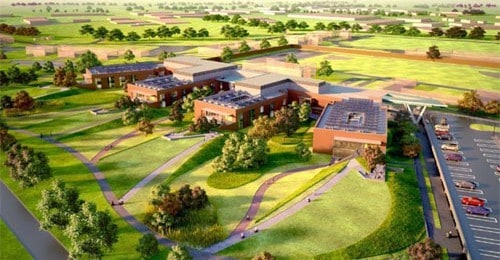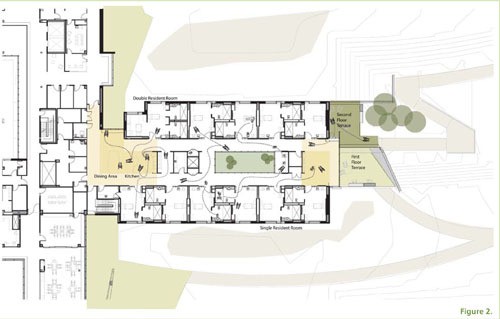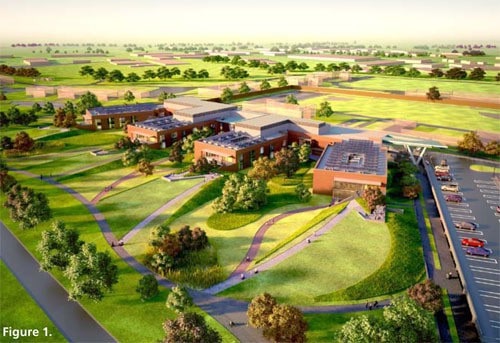Blog
2 Design Solutions that Improve Long-Term Care

Improving Long-Term Care – Today’s Solutions
Making the decision to move a loved one into a nursing home is never easy. One usually tries to find a place where their loved one will be well cared for, comfortable and where they can feel at home.
Long term care facilities are reinventing themselves as a response to market needs. Buildings are being redesigned so that medical care can be delivered more efficiently and the atmosphere fosters resident health in mind, body and spirit.
Two concepts in particular are leading the way causing major change in the way nursing homes are being built.
1. Planetree
Planetree is a model and a nonprofit organization – http://planetree.org. The model – shown below is typically a resident pod that features 11 rooms surrounding an open space. An exterior courtyard brings daylight to the area’s center.

A typical resident pod features 11 rooms surrounding an open space. An exterior courtyard brings daylight to the area’s center.
This model is typical because Planetree-the organization, believes that healthcare organizations would benefit from creating facilities that are patent-centered, providing safe, accessible, high-quality care in a healing environment.
Planetree the organization uses it’s believes (listed below) to create Planetree Models.
Planetree Beliefs:
- We are human beings, caring for other human beings.
- We all are caregivers.
- Caregiving is best achieved through kindness and compassion.
- Safe, accessible, high-quality care is fundamental to patient-centered care.
- Providing a holistic approach to meeting people’s needs of body, mind, and spirit
- Families, friends and loved ones are vital to the healing process.
- Access to understandable health information can empower individuals to participate in their healthcare.
- The opportunity for individuals to make personal choices related to their care is essential.
- Physical environments can enhance healing, health, and well-being.
- Illness can be a transformational experience for patients, families, and caregivers.
2. Greenhouse
The Greenhouse Project (www.thegreenhouseproject.org) creates a small intentional community for a group of elders and staff. This model is intended to de-institutionalize long-term care by eliminating large nursing facilities and creating a habilitative social setting (of groups of six to ten elders).
Each elder is provided a private room with private shower and high levels of sunlight. The rooms are in a home-like pod surrounding a great room that has a kitchen, dining room, and living space with a fireplace and hearth.

Four resident pods located on each of two levels and an attached parking deck are included in the proposed new facility design for the Brockton, Mass., VA.
Implementation
The interiors are designed to be warm and aesthetically pleasing, and there are few medical signposts.
The new models create rooms around open space and focus on building exterior courtyards that bring daylight into the center of the space. The gardens and daylight have been proven to have healing effects.
Nurse stations are all centralized so that they can provide the best care.
The construction and operational cost of incorporating the Planetree and Greenhouse models may be a little higher due to the smaller pods with fewer residents in one place. However, the benefits of providing a healthier environment for the residents can far outweigh any additional cost.
Currently
These new concepts are being incorporated into the design of the new VA SCI/D Long Term Care Facilities at the Dallas VA (30–60 beds); the Bronx, N.Y., VA (42 beds); and the Brockton, Mass., VA (96 beds). Paralyzed Veterans of America Architecture is directly involved with the design process of all three facilities.
Figure 1 shows the proposed new facility design for Brockton, which has two levels with four resident pods located on each level and an attached parking deck.
Figure 2 shows a typical resident pod layout with 11 resident rooms. The rooms surround open space in the middle containing an intimate exterior courtyard that brings daylight into the center of the pod. Residents can access the courtyard and be around nature and its healing effects.
Also located in the center of the pod are a day/living room, dining room, and kitchen. All these spaces have warm interior finishes with wood used throughout. A small nurses’ station is centrally located but not highly visible, in an effort to reduce any feelings of being in an institutional environment.
Inside Touches
Wall sconces, rather than the typical two-by-four-foot fluorescent lights, add to the home-like environment. The residents’ rooms (Figure 3) are spacious, with a large window wall and flat screen television. Wood is used for desk, night stand, and wardrobe finishes.
The architect is proposing a new vinyl tile product with a thin carpet finish on top. The room is reminiscent of a hotel and is so nice even nonresidents would like to live there.

Residents’ rooms are spacious, with a large window wall and flat screen television, as well as wood desk, night stand, and wardrobe finishes.
Outside
Landscaping plays a large role in the exterior design as numerous courtyards have been created that foster resident, visitor, and staff interaction.
Many paths lead from the courtyards and building exits and intertwine, all connecting to an exterior loop path that allows all building users to participate in a healthy exercise routine.
There is also a dedicated therapy courtyard and an outdoor sports activities area with basketball and bocce ball courts. Other activities proposed for the courtyards are croquet, checkers, dominoes, shuffleboard and horseshoes.
Changing Perceptions
The construction and operational cost of incorporating the Planetree and Greenhouse models may be a little higher due to the smaller pods with fewer residents in one place. However, the benefits of providing a healthier environment for the residents can far outweigh any additional cost.
It’s commendable that the Department of Veterans Affairs has embraced these two concepts to create home-like environments for its veterans in the long-term care setting. In the future, with continued implementation of these two concepts, negative perceptions of living in a long-term-care environment should change for the better.
Read similar posts:
Read: Let the Sunshine In
Read: Summoning Nature for Healing
Read: Bringing Natural Elements Closer to Patients, Family, and Caregivers
Read: Patient Room 2020 – The Hospital Room of the Future








1 Comment
Featured Artist: Interview with Susan Frampton of Planetree, Inc. | Wikoff Design Studio
March 6, 2015[…] Read similar posts: https://wikoffdesignstudio.com/2-design-solutions-that-improve-long-term-care/ […]